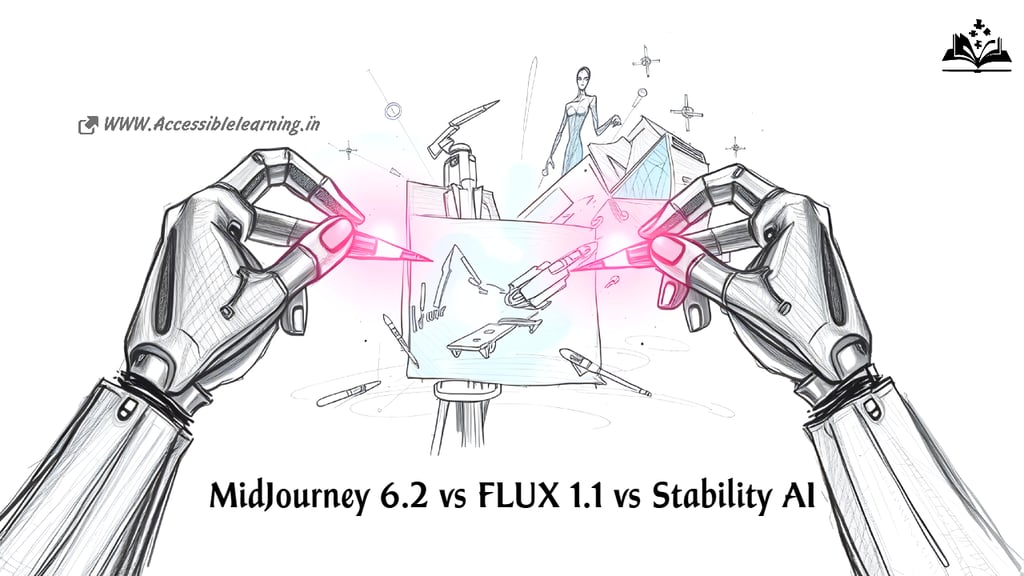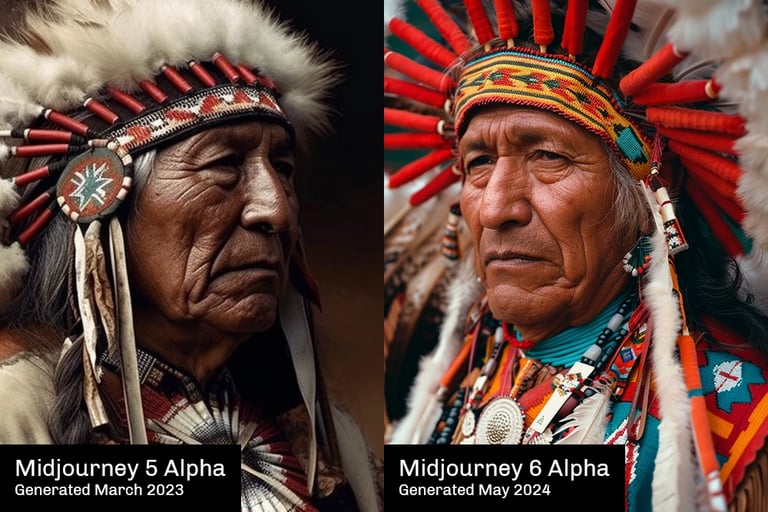
AI Art Battle: Comparing MidJourney, FLUX, and Stability AI in 2025
Discover the ultimate showdown between MidJourney 6.2, FLUX 1.1, and Stability AI. Compare their image quality, customization, ease of use, pricing, and technical capabilities to find the best AI image generator for your needs.
AI/FUTUREAI ART TOOLSARTIST/CREATIVITYEDITOR/TOOLS
Sachin K Chaurasiya
3/19/20255 min read


AI-generated art has taken the world by storm, with tools like MidJourney 6.2, FLUX 1.1, and Stability AI pushing the boundaries of creativity and realism. Each of these platforms offers unique strengths, but which one is best suited for your needs? Let’s break down their capabilities, features, and differences to help you decide.
Overview of AI Image Generators
Before diving into a direct comparison, here’s a quick look at what each AI tool brings to the table:
MidJourney 6.2: A high-end AI art generator known for its painterly, surreal, and highly detailed outputs, widely used by digital artists and designers.
FLUX 1.1: A relatively new but powerful AI model specializing in photorealistic images and dynamic compositions, catering to professionals and casual users alike.
Stability AI (Stable Diffusion XL, SDXL, etc.): An open-source AI model offering incredible flexibility, fine-tuning, and high-resolution image generation, favored by developers and enthusiasts.
Image Quality & Style
MidJourney 6.2
Known for its artistic and cinematic visuals.
Produces highly detailed, dreamlike, and fantasy-driven artwork.
Strong in blending colors and creating moody atmospheres.
Great for concept artists, fantasy illustrators, and digital creatives.
Handles lighting, reflections, and textures with extreme precision.
Sometimes struggles with strict realism and fine anatomical accuracy.
FLUX 1.1
Focuses on hyperrealism and dynamic compositions.
Captures fine details like skin textures, lighting effects, and realistic shadows.
Suitable for fashion photography, product marketing, and 3D renders.
Sometimes struggles with abstract or surreal styles.
Excellent at generating lifelike human faces, landscapes, and mechanical designs.
Can replicate cinematic photography techniques such as depth of field and motion blur.
Stability AI (Stable Diffusion XL & Variants)
Offers versatile styles—from realism to anime to impressionism.
Can be fine-tuned with custom models and extensions.
Image quality varies depending on training data and prompt engineering.
Best for developers, researchers, and those who like tweaking AI models.
Newer versions (like SDXL) provide higher resolution and better coherence in human anatomy.
Works well with ControlNet and LoRA models for better control over poses and compositions.
Winner: If you prefer artistic and painterly styles, MidJourney 6.2 is the best. For photorealism, FLUX 1.1 leads the way, while Stability AI is the most versatile.


Customization & Control
MidJourney 6.2
Uses a Discord-based interface.
Limited but effective prompting techniques and stylization options.
Lacks extensive fine-tuning or model customization.
Offers a variation tool to explore different interpretations of an image.
Allows multi-prompting to mix different artistic elements.
FLUX 1.1
Offers a high degree of control over realism and composition.
Includes pose-guided generation and inpainting options.
Provides pre-trained styles for easier customization.
Has masking features for selective edits.
Supports image-to-image transformations with finer adjustments.
Stability AI (SDXL & Variants)
Completely open-source and customizable.
Can be fine-tuned, trained on custom datasets, and modified with extensions.
Requires technical knowledge to get the best results.
Supports text-to-image, inpainting, outpainting, and depth-to-image modifications.
Works with third-party tools like ComfyUI, InvokeAI, and DreamBooth.
Winner: If you want out-of-the-box usability, MidJourney 6.2 wins. For controlled photorealistic renders, FLUX 1.1 is superior. If you need full control and customization, Stability AI is unmatched.
Ease of Use
MidJourney 6.2
Works through Discord, which may be confusing for some users.
Simple text prompts generate stunning results with minimal effort.
Limited user interface compared to web-based platforms.
FLUX 1.1
Has a web-based platform with an intuitive UI.
Easier to use than Stability AI but not as seamless as MidJourney.
Provides guidance on optimal prompts for better results.
Stability AI (SDXL & Variants)
Requires installation and setup (or use of online generators).
Steep learning curve but offers maximum flexibility.
Works with Google Colab, RunPod, and local GPUs for different user preferences.
Winner: MidJourney 6.2 is the most user-friendly, followed by FLUX 1.1. Stability AI is the most complex but offers the most control.
Pricing & Accessibility
MidJourney 6.2
Subscription-based ($10–$60/month depending on usage).
No free version.
Requires Discord account.
FLUX 1.1
Offers both free and premium tiers.
Premium plans range from $15–$50/month.
Accessible via web-based platform.
Stability AI (SDXL & Variants)
Completely free (self-hosted) but requires GPU power.
Cloud-based versions may have usage fees.
Many third-party apps use Stability AI for commercial services.
Compatible with free-to-use models on Hugging Face.
Winner: Stability AI is the most affordable (if you have the hardware). FLUX 1.1 offers the best balance between free and paid features. MidJourney 6.2 is premium-only but delivers high-end results.


FAQs
Which AI image generator is best for high-quality artistic visuals?
MidJourney 6.2 is the best for artistic and painterly visuals. It excels in fantasy, surrealism, and cinematic aesthetics, making it ideal for concept artists and digital creatives.
Which AI tool is best for photorealistic images?
FLUX 1.1 specializes in hyperrealism and detailed compositions, making it the best choice for fashion photography, product marketing, and human portraits with lifelike details.
Can I fine-tune or customize the AI models?
MidJourney 6.2 has limited customization options and works via Discord.
FLUX 1.1 offers more control with pose-guided generation and inpainting.
Stability AI (Stable Diffusion XL) is fully open-source and can be fine-tuned, trained on custom datasets, and modified using third-party tools like LoRA and ControlNet.
Which AI image generator is the easiest to use?
MidJourney 6.2 is the easiest to use but requires Discord.
FLUX 1.1 has an intuitive web-based interface with more control.
Stability AI is technically complex and requires installation or cloud hosting.
Which AI tool is the most affordable?
MidJourney 6.2 requires a paid subscription ($10–$60/month).
FLUX 1.1 has both free and paid tiers.
Stability AI (Stable Diffusion) is free if self-hosted but may have cloud-based costs.
Can these AI tools generate text within images?
MidJourney 6.2 and FLUX 1.1 struggle with precise text generation.
Stability AI (SDXL) can generate text more accurately with fine-tuning.
Which AI tool is best for commercial use?
MidJourney 6.2 and FLUX 1.1 allow commercial use but have license restrictions based on subscription plans.
Stability AI allows full commercial use if you self-host the model.
Which AI is best for developers and AI researchers?
Stability AI (Stable Diffusion XL) is best for developers due to its open-source flexibility, ability to run custom models, and support for advanced AI modifications.
Can these AI generators edit existing images?
MidJourney 6.2 has basic variation tools but lacks direct inpainting.
FLUX 1.1 offers inpainting and masking features for detailed edits.
Stability AI supports image-to-image transformations, inpainting, and ControlNet for advanced editing.
Which AI model is best for professional graphic design work?
For artistic and creative designs: MidJourney 6.2
For realistic branding, photography, and advertisements: FLUX 1.1
For technical and customizable AI-generated graphics: Stability AI
Which One Should You Choose?
For stunning, artistic images with minimal effort: 🏆 MidJourney 6.2
For photorealistic renders and high customization: 🏆 FLUX 1.1
For maximum control, open-source flexibility, and free access: 🏆 Stability AI
Each tool excels in different areas, so your choice depends on your specific needs. If you’re an artist or designer, go with MidJourney. If you’re into photorealism and high-detail composition, FLUX 1.1 is a great bet. And if you love customization and open-source AI, Stability AI is your best option.
What are your thoughts on these AI tools? Let us know which one you prefer! 🚀
Subscribe to our newsletter
All © Copyright reserved by Accessible-Learning
| Terms & Conditions
Knowledge is power. Learn with Us. 📚


